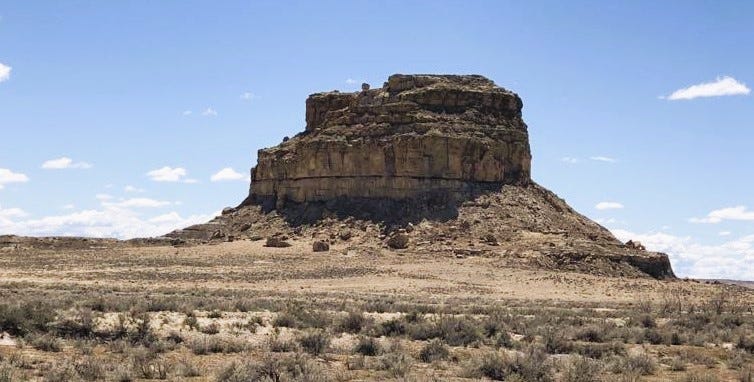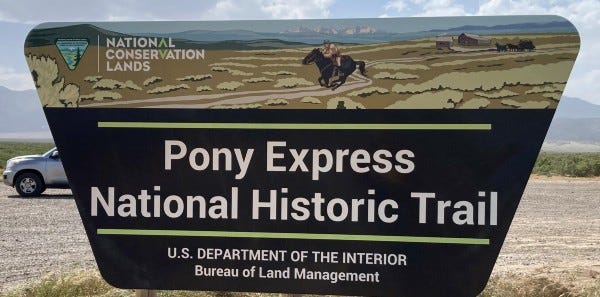The Ancient Ancestral Sun Dagger Remained Hidden for Hundreds of Years
Until it was rediscovered in 1977 in Chaco Cultural Historic Park
The Ancestral Pueblo people who lived in Chaco Canyon a millennia ago needed a way to mark time so that tasks for their survival such as gathering, farming and hunting could be completed at the right time of year.
An astronomical marker called the Sun Dagger was found on Fajada Butte. It consists of three stone slabs leaning against a cliff face that is adorned with two carved spiral petroglyphs.

When driving into Chaco Culture National Historic Park, Fajada Butte is hard to miss and is one of the first things you will see. The summit of the butte is 6,623 feet above sea level, and its cliffs rise 450 feet above the canyon floor. Near its summit is the Sun Dagger, one of the most famous petroglyphs in the southwest.
A Volunteer “Rediscovers” the Sun Dagger in 1977
When the residents of the canyon abandoned the area approximately 700 years ago, the Sun Dagger was left behind. In 1977 Anna Sofaer rediscovered the Sun Dagger while she was volunteering on a project to document the rock art in Chaco Canyon.

She noted three large stone slabs leaning against the cliff which shaded a cliff wall. Two spiral petroglyphs are carved on the shaded part of the wall, one large and one small. Sunlight is filtered through the gaps in the stone slab creating a “dagger” shaped beam of light on the cliff wall.
She noticed that the location and number of light “daggers” changed depending on the time of year. Suspecting that this was no accident, she repeatedly returned at different times during the year and confirmed the phenomena.

Sofaer coined the term “Sun Dagger”, because of how sunlight forms the shape of a dagger going directly through the middle of the spiral during the summer solstice.
A Spiral Sundial
We mentioned the two spiral petroglyphs and three large sandstone slabs leaning against a cliff face. Sunlight filters through the gaps in the sandstone and, at various times throughout the year, the placement of the “dagger(s)” change. At the summer solstice, a vertical shaft of light crosses the main spiral exactly at its center. On the winter solstice, two shafts of light perfectly bracket the same spiral. Light shafts strike the center of a smaller spiral nearby on the spring and fall equinoxes.
While the petroglyphs and the use of the slits in the rock are definitely intentional, experts still debate whether the stone slabs were placed in their location or ended up that way by some natural process.
It’s impossible to say with certainty when the sun dagger was built, or rather, when it was carved into the rock. However, it can probably be hypothesized that its construction coincided with the establishment of Chacoan culture around 900 CE.
In addition, a “ramp” was built at the base of Fajada Butte around this time, identified by numerous signs of trail construction. This probably means that access was needed for a large portion of the Chacoan people, presumably for ceremonial purposes.
Unfortunately, the Sun Dagger is Off-limits to All Visitors
By 1989 the three sandstone slabs in front of the petroglyph had shifted, altering the location of the “dagger of light”. It no longer crosses through the center of the spiral during the summer solstice. The shift was attributed to erosion caused by recent foot traffic, so the National Park Service closed the butte to visitation.

Archeoastronomy in Chaco Canyon
This was the last of three posts about archeoastronomy phenomena in Chaco Culture National Historic Park. Archeoastronomy is the study of how people in the past have understood the phenomena in the sky, how they used these phenomena and what role the sky played in their cultures.
Please read my other posts if you haven’t already. My first post was about a petroglyph that is thought to be a depiction of a total solar eclipse that occurred in 1097 CE. My second post was about two pictographs that are believed to be records of a supernova that was seen in 1054 CE and the return of Halley’s Comet that happened in 1066 CE.
Next Time
Young men once rode horses to carry mail from Missouri to California in the unprecedented time of only 10 days! This relay system along the Pony Express National Historic Trail crossing eight states was the most direct and practical means of east-west communications in 1860. From Missouri to California the Pony Express riders could deliver a letter faster than ever before.
Each June, members of the National Pony Express Association recreate the Pony Express in a Commemorative Re-Ride over a 10-day period. Letters are carried in a mochila over the original trail. The 1,966 mile, eight state event is conducted 24 hours a day until the mail is delivered to its destination. This national event is an opportunity for all young and old to ride the Pony Trail and to receive mail via the Pony Express!








Two photos of sun dagger have two left, but no right. Amazing what human foot traffic can do to shift rocks positions.
Another very informative issue. I look forward to these tremendously